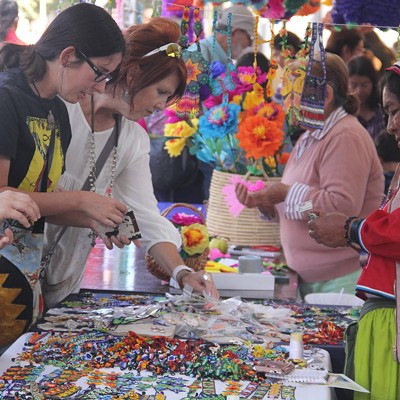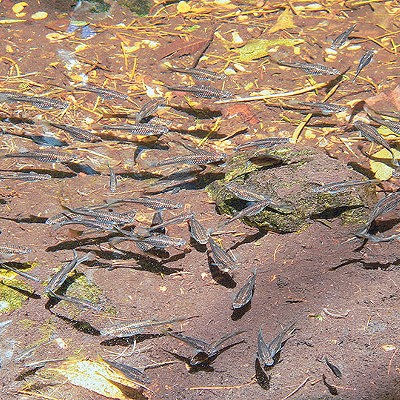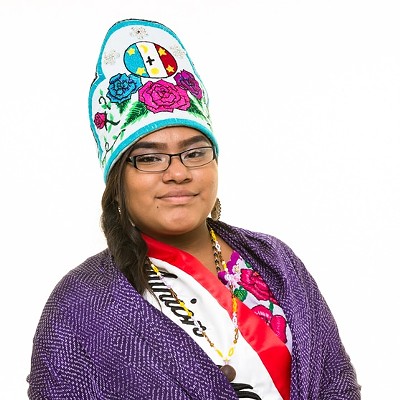Just north of Hermosillo, Amalia Reyes discovered a roadside shrine dedicated to Our Lady of Fatima.
"It's beautiful," Reyes says. It's painted turquoise, one of her favorite colors, and adorning the altar are masses of small flowers, made of cut and folded paper.
Reyes and her godmother, Irene Sanchez, were experienced flower-makers when they first came upon the tiny Fatima blossoms. In fact, Reyes is a master artisan who will demonstrate the sacred Yaqui art of flower-making this weekend at Tucson Meet Yourself.
But the flower was in an unusual "pinch-y pattern," and neither she nor Sanchez could figure out how to make it.
"Then I had a dream, and the Virgin of Fatima appeared," Reyes recounts, sitting in the flower-strewn front room of her westside house. "She said, 'This is how you do it. Like this—you make it with your hand.' I woke up in the morning and started doing it."
Reyes quickly mastered the technique she learned from the Virgin—"you pinch the edges with your fingernails"—and added the blossom to her repertoire of some 50 or 60 flower designs. But she reserves the Fatima flower for one use, and one use only: the wakes of infants.
"It's for babies who have passed," she says. "It's really beautiful, delicate. It's special for them."
For Reyes, 54, the colorful flowers she makes in her house near "A" Mountain are not mere crafts. They are an essential part of the Yaqui "flower world," she says. "Flowers represent the sacred-ness of our religious belief, and repel evil in our world."
Reyes first got connected to Tucson Meet Yourself in June, when Dr. Maribel Alvarez saw her flowers at the San Juan Festival.
"I could tell right away that she had a commitment and devotion to the craft," says Alvarez, a UA professor, folklorist at the university's Southwest Center and chair of the board of Tucson Meet Yourself. "You can tell when an artist has that special touch, or signature."
Tucson Meet Yourself is best known for its cornucopia of ethnic foods and its nonstop musical and dance performances. But festival planners also hope to showcase the deep cultural significance of Reyes' flower-making—and of traditional arts practiced by scores of other participants.
Reyes' flowers "are used for ritual," Alvarez notes. And like those paper flowers, other carefully curated handicrafts on display deliver a "cultural message. This is not just some superficial dog-and-pony show."
Now in its 38th year, the beloved local festival will take place Friday, Saturday and Sunday in six downtown plazas. Organizers tally up 110 distinct presentations by more than 170 artists hailing from 65 ethnic and occupational groups. Music, dance and a low-rider exhibition are on the bill, along with a new health-and-wellness section, and a Sonoran Pavilion.
"This is the first year we officially invited Sonora," Alvarez says. "There will be folk arts, and heritage food and drink"—including an adults-only mescal-sipping corral. In a climate of animosity toward the borderlands, "the Sonorans were so grateful to be invited."
Reyes' flower-making demos on Saturday and Sunday at the Yaqui Pavilion in the Tucson Convention Center Plaza are part of a greatly enlarged folk-crafts division.
"There were always folk artists, but we expanded that significantly last year," Alvarez says. The crafts on display are all over the map, literally. They include Arizona ranchers' rawhide ropes, African-American handmade hats, papel picado (cut paper) by Mexican Americans, and clothing tailored by Ghanaians.
"We've been working with new groups in the refugee communities—tailors and seamstresses," Alvarez says. "Everyone comes with some material. People didn't think of it as an art form, just as an occupation. They realize that here in the U.S., they can use it to express their culture."
Reyes says she's a little nervous about making her flowers in public at the festival. She normally works in her house, where she lives with her husband (a schoolteacher) and her two younger children, both students at Pima Community College. Her studio is a front room painted deep orange, another of her favorite colors. Paper flowers are scattered over the work table, and her flower designs are on her computer screen. At her feet are large plastic boxes filled with crepe paper in lavender, turquoise, red and green.
"I'm always on the lookout for the right paper," she says. The best comes from Sonora—the Yaqui homeland. She buys much of it at a candy store in Nogales, and her "godsisters" bring good paper to her whenever they can.
She doesn't often find herself crafting flowers for a secular event. She typically creates the blossoms for churches, sometimes for the Yaqui church of San Martín in South Tucson, and more often for her home parish of San Ignacio de Loyola in the Yaqui settlement of Old Pascua on Grant Road.
"I do 200 flowers for the whole front of the church on Easter," she says, and "also for San Ignacio's special day. I make roses for the pascolas—they dance for different fiestas, especially for the feast of San Ignacio."
In fact, October is her "flower month," she says, smiling. Besides Tucson Meet Yourself—for which she's on a last-minute tear, turning out 10 flowers a day to decorate the Yaqui Pavilion—she wants to make flowers for Oct. 13, the date the Virgin of Fatima is said to have last appeared on Earth in 1917.
But she's fast. Demonstrating how to make the large "spiky" variety, she expertly turns out a turquoise bloom in about 60 seconds. She folds the long rectangular stretch of paper into a small square, and cuts into it with scissors, slashing a diagonal design through the layers—in the way anyone would cut out a chain of paper dolls. Then she opens it out into its full prickly glory, and folds and twists it into a blossom.
October also has sadder connotations. As Reyes crafts her flowers, she thinks of her late parents, Maria Amacio Molina and Juan Espinoza Molina, agricultural workers who once picked cotton in the fields of Marana.
Reyes was born in the little settlement of Cortaro, its former fields now remembered in the name of Cortaro Farms Road. She used to go to the fields with her mother as a small child, watching as her mother stuffed the cotton into a long cloth bag. She remembers her mother making the traditional flowers by curling paper with a scissors' blade, a tool that nowadays has been supplanted by pencils.
One of 10 children, Reyes moved with the family to Old Pascua on Grant Road as a child, and began working in Pascua Pueblo on the southwest side in the early 1980s. (Today, she runs the tribal library.) By then, the tradition of making flowers was disappearing, with the handmade paper blooms supplanted by store-bought plastic. Tribal leader Anselmo Valencia Tori asked Reyes and Sanchez to revive the practice, Reyes says.
Her teachers were some of the older women at Pascua, as well as her mother, and Reyes also took inspiration from a woman in Nogales who made the large flowers that are now her own specialty. And, of course, she learned to make the babies' blossoms from the Virgin.
Reyes is happy that she and her godmother helped revive the sacred tradition.
"Irene Sanchez and I started making them. People got curious and wanted to learn. It was dying. Now it's good. People are making them, even young men. We kind of saved that."














